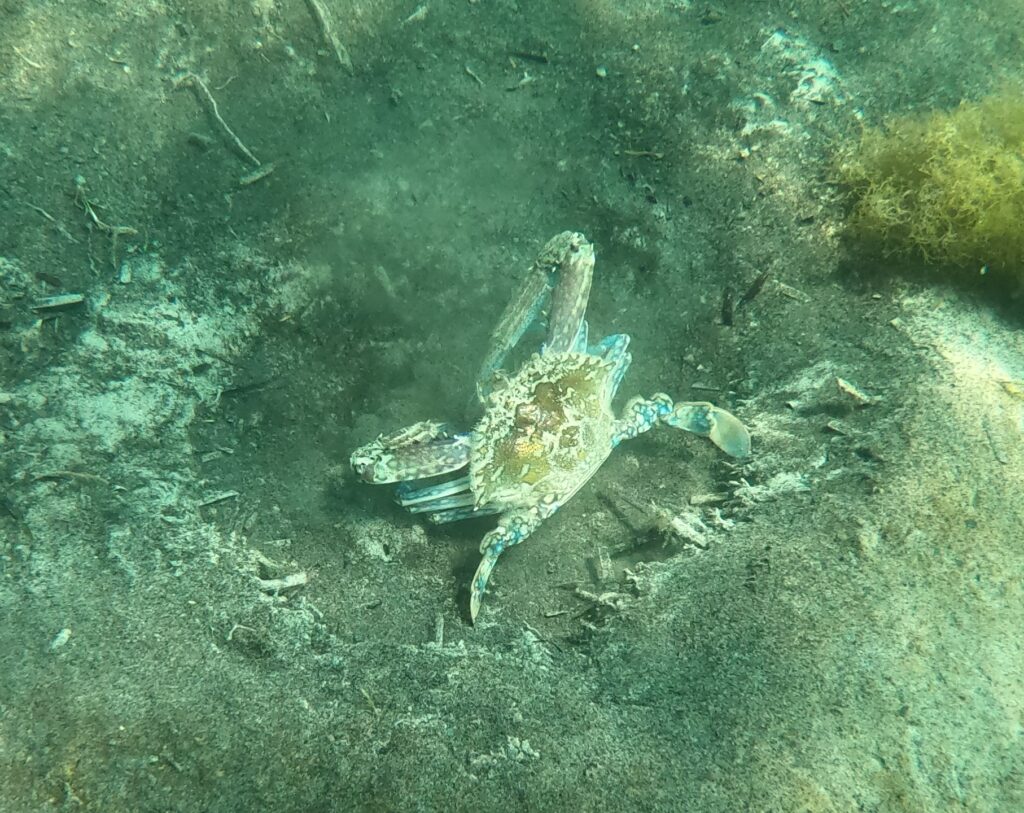Crab; Blue Manna
Portunus pelagicus
The blue manna crab is a member of the family Portunidae, or swimmer crabs, which are characterised by the bluish colouration of males, prominent spines on the edge of a broad, flattened carapace, a smoothly curved rear of the body and flattened, paddle-like hind legs to aid in swimming. They are the most active family of crabs and use their front chelipeds (pincers) for catching and grasping prey, as well as to defend themselves. Female crabs (known as jennies) are a duller green to brown colour compared to males, have a prominent spot at the base of the claws and a more rounded carapace. The blue manna crab is a large, strong swimming crab, with the carapace measuring up to 25 centimetres in width and a claw span up to 80 centimetres.
Courtship and mating of the blue manna crabs generally occurs in February and March. The male will court the female crab for four to ten days before mating. Courtship involves the male crab carrying the female crab beneath him during this period. While courting, the male is extremely aggressive threatening or striking with its claws at anything that moves. Copulation takes place when the female is in the soft-shell condition. The female retains viable sperm within an internal structure called a spermatheca until the following summer. The broad female ‘flap’ which bears appendages is where her eggs are attached after spawning. When the eggs hatch, they become minute, transparent larvae which drift in the sea. The larvae pass through many different forms (metamorphosis) before assuming the typical adult shape. The crabs then settle as juveniles in very shallow sandy habitats and grow rapidly, reaching maturity after only one year.
Blue manna crabs inhabit sandy, muddy, algal and seagrass environments in estuaries, sheltered bays and offshore waters to 60 metres depth. Blue manna crabs are non specific active predators and scavengers. They remain buried under sand or mud during the day, ready to ambush unsuspecting small fish and invertebrates. At night they become mobile, using the current to help them locate food such as bivalves, fish and to a lesser extent algae and seagrass. A tropical species, the blue manna crab occur from Nickol Bay to Cape Naturaliste on the Western Australian coastline. They are also found off northern and eastern Australia and are widely distributed in the Indian and Pacific oceans.
The species is commercially important throughout the Indo-Pacific where they may be sold as traditional hard shells, or as “soft shelled” crabs, which are considered a delicacy throughout Asia. Western Australia’s annual blue manna crab commercial catch usually exceeds 1000 tonnes, making up more than half Australia’s total catch of this species. Hundreds of tones are also caught each year by Western Australian recreational fishers leading to concern over the sustainability of WA’s blue manna crab populations. As a result size limits, gear restrictions, seasonal crabbing closures and bag and boat limits apply.
Other common names include: blue swimmer crab, sand crab, blue crab, flower crab (used in east Asian countries)
Occurrence at the Busselton Jetty:
Due to the fact that the blue manna crab remain concealed for the majority of the day, this species is rarely observed from the underwater observatory. They do however occur in abundance in the clear, calm, shallow waters of Geographe Bay and support a strong recreational fishery in the area.
Image by: O. Rynvis
